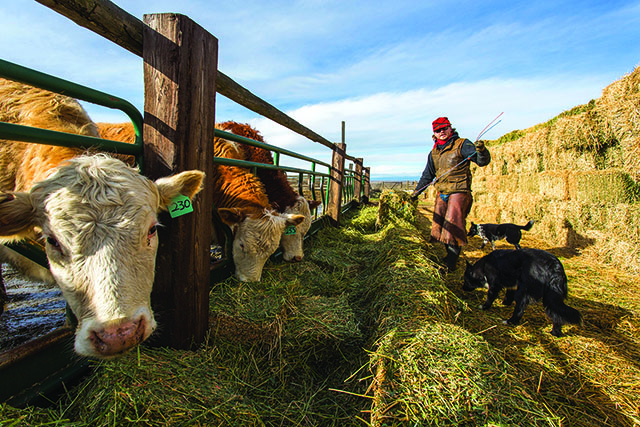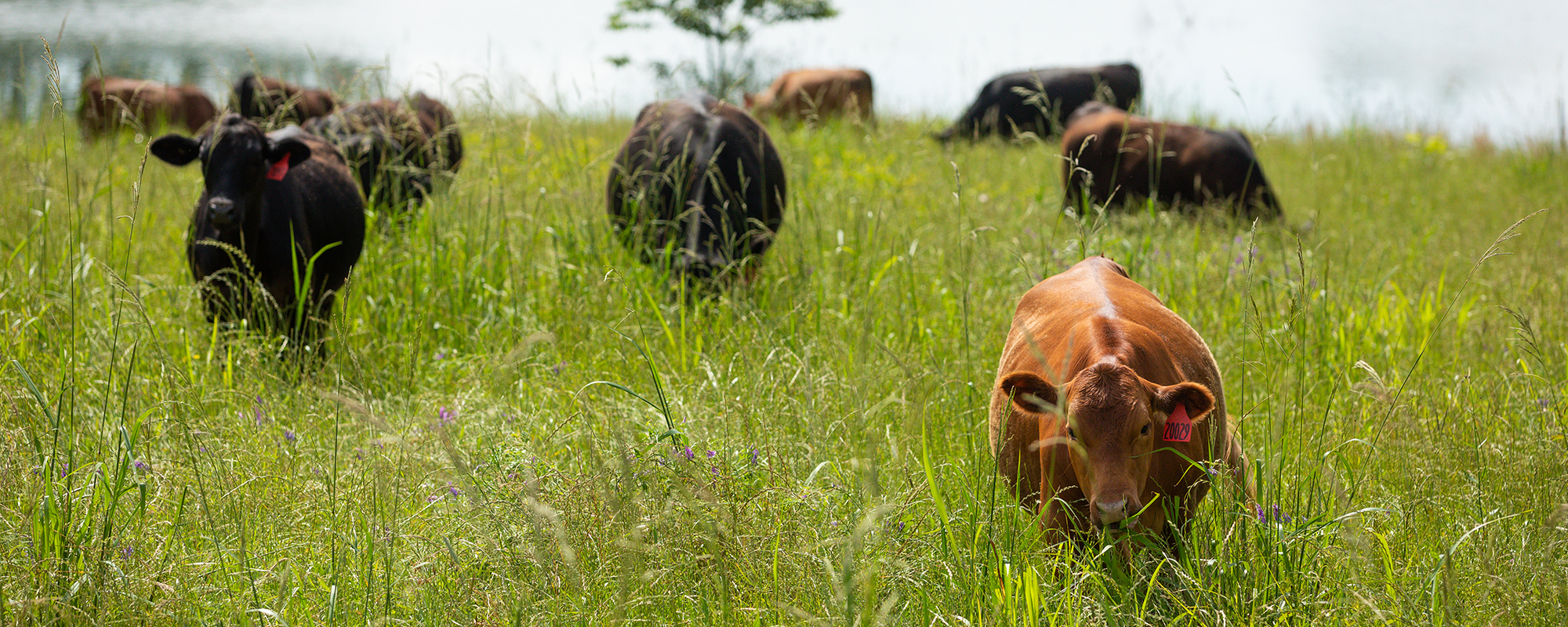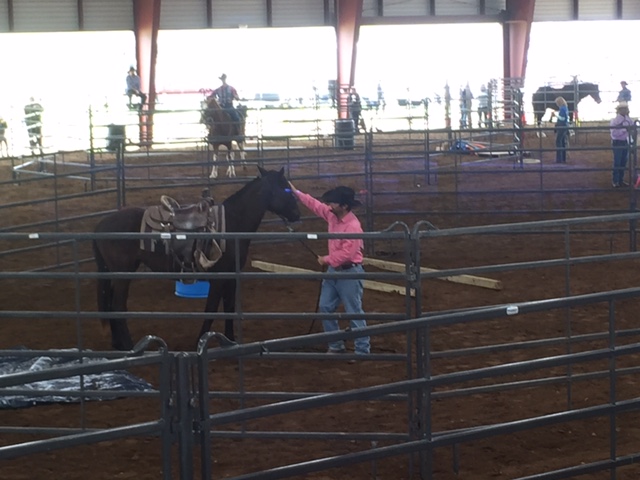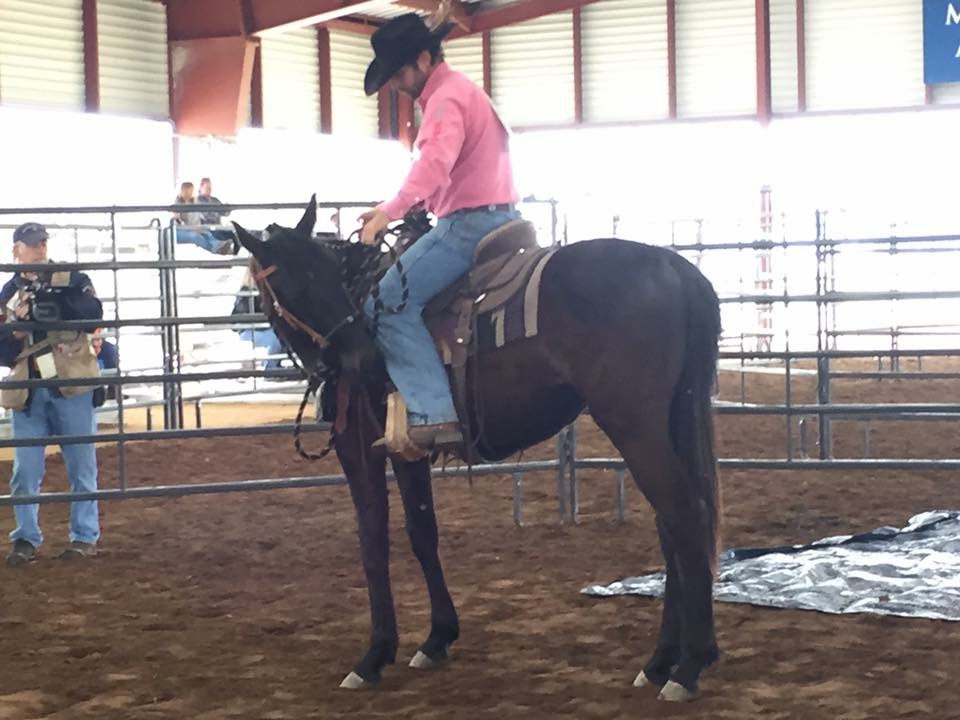HOME
The Natural Horseman – Staying the Course

By Steve Stevens
I am sitting at Ronald Reagan National Airport in Washington, DC. It is 3:30 in the morning, and I am waiting for a 5:30 a.m. flight. I just came from competing in the Colt Starting Challenge USA competition in Doswell, Virginia, at the Virginia Horse Festival. I ended up finishing second place with a two and a half year old Warmblood named Quest. This was an interesting one for me because Quest was by far the most nervous horse I have had at any of the colt startings.
When I got to work in the first round, it became evident that he wasn’t going to be easy. To start, I could hardly touch him and I was concerned I wouldn’t be able to get him saddled. But I just worked away with just rubbing and releasing and before long I got him saddled. He was real tight. I just kept reminding myself to be there for him and he started to free up. Every time I stepped up in the stirrup I could feel his body tense up. So I would step up and back down again. I kept doing this until I felt him take a breath. I went through that process for a while until it finally came time to take a deep seat and see how it turned out.
As long as I kept moving, rubbing him, rocking my hips back and forth, he seemed to be all right. He actually moved out pretty good. The time ended quickly for the day and I knew I didn’t get nearly enough accomplished for the competition. In the grand scheme of things he had made huge leaps and bounds. I needed to let it go and hope that he would continue growing tomorrow.
I got to check out Fredericksburg, Virginia, a little bit that evening. I feel it is always important to allow my horse journey to help me take advantage of exploring places I have not seen, especially historical and beautiful places to keep me grounded. The history there was amazing. To stand where our founding fathers stood and fought for our great country was pretty special.
The second day Quest came around quickly. I had to watch him, though. He needed a lot of leadership. Anytime I got distracted I could feel him distancing himself. I couldn’t have been prouder of him. It was less than three hours ago that he was scared to be touched. It is really incredible that horses can allow us to ride them. As I kept working away, I thought a lot about the horses that had carried soldiers through battles in the area. It should always be such an honor to ride a horse after what they have done for our country. I went into the final round in first place. Quest got a little herd bound to the other horses once he was in the arena by himself. He never concerned me, but he was hard to maneuver around the arena.
We got through all the obstacles, dragging a log, throwing a rope, and other tasks. This little Warmblood tried his heart out for me. He had a big heart and I am glad that I was the first human on his back. I learn something every time I work a horse. Quest taught me the importance of staying the course and just working away. He made it through. It was an amazing weekend. It is time to catch my flight back to Texas. Have sweet dreams, my dear friend Quest.
HOME
Farm and Ranch Injuries

By Barry Whitworth, DVM
In January, I attended the Oklahoma Veterinary Conference. While waiting for one of the sessions to start, a classmate of mine commented how many of the attendees walk with a limp, used a cane, and/or have damaged hands. We all agreed that working with animals is hard on the body. In general, anything associated with farming and ranching is dangerous.
Most farmers and ranchers know that agriculture is a dangerous occupation. According to United States Bureau of Statistics, workers involved in agriculture, forestry, and fishing had the highest occupational fatality rate in 2022. The fatality rate of 23.5 per 100,000 full-time equivalent (FTE) workers for this group is much higher when compared to the overall occupation fatality rate of 3.7 per 100,000 FTE. Most of the agriculture-related fatalities are associated with transportation, such as tractor overturns, and vehicle crashes, but a fair number involve livestock.
To read more, pick up a copy of the March issue of NTFR magazine. To subscribe by mail, call 940-872-5922.
HOME
Jesses Jewelz

By Jesse Kader
Comfy and keep it western. That’s the name of the game this month. It’s hot and who wants clingy clothing? This jumpsuit is perfectly comfortable and relaxed without forfeiting the fashion. Dress it up or keep it casual. See this and more at www.jessesjewelz.com.
HOME
Noble Research Institute Expands New Program Offering Farmers and Ranchers the Essentials of Regenerative Ranch Management

The educational program has been expanded to three new locations, empowering ranchers and farmers to monitor and improve the health of their land, livestock and livelihood through regenerative principles.
ARDMORE, OK–September 12, 2023 – Noble Research Institute announced the expansion of Essentials of Regenerative Ranching, a new educational program designed to help ranchers enhance and restore the land, making it more resilient and reaching livestock grazing goals through regenerative management. Essentials of Regenerative Ranching provides producers with practical tools, hands-on experience and guidance to make data-driven decisions to decrease costs and improve profit.
The Essentials of Regenerative Ranching course has been expanded to three new locations in Texas and Oklahoma. Registration is open now at www.noble.org/essentials. Seating is limited, so early registration is recommended.
Texas A&M
College Station, Texas
October 17 – 18
O.D. Butler, Jr. Animal Science Complex
Noble Research Institute
Ardmore, Oklahoma
October 31 – November 1
Pavilion Center
Texas A&M
Kingsville, Texas
November 7-8
Caesar Kleberg Wildlife Center
“Program participants gain working knowledge and experience of monitoring and improving the health of their soil, grazing livestock more strategically and making informed financial decisions,” said Hugh Aljoe, Noble Research Institute’s director of ranches, outreach and partnerships. “We use a mix of classroom and field work to send producers home with the tools they need to begin making changes on their ranch.”
Farmers and ranchers navigate uncertainty from weather, fluctuating market prices and escalating costs of inputs. Many producers are seeking new tools that offer greater control and reduce their operational uncertainty. Through this course, ranchers and farmers will calculate their financial situations, determine initial stocking rates, carrying capacity and grazing goals.
“The course is well-suited for ranchers of all experience levels and all types and sizes of operations,” Aljoe added. “No matter your situation, this program will transform the way you think about your ranch.”
The Essentials of Regenerative Ranching program allows producers to overcome obstacles, become more informed problem-solvers and increase the productivity of their grazing lands. By participating in this program, ranchers join a community of like-minded producers who are shaping the future of ranching and leaving a lasting impact on their land and families. “If I had known what I learned in this course when I started my regenerative journey, I could have avoided some key mistakes,” said Tana McCarter, a rancher, and Essentials attendee. “I left with the tools I needed to monitor my soil health and financial progress. I’ll now have the right data to make informed decisions on how to meet my regenerative goals.”
Noble Research Institute is an independent nonprofit agricultural research organization dedicated to guiding farmers and ranchers in applying regenerative principles that yield healthier soil, more productive grazing land, and business success.
At Noble, researchers, facilitators and ranch staff work together to share with farmers and ranchers the skills and tools to regenerate the land in a profitable manner. Noble is focused on the regenerative management of the nation’s grazing acres, which directly impacts pasture and range environments, wildlife, pecan production, and livestock production. Regenerative management recognizes that each decision made on the ranch impacts the interactions of the soil, plants, water, animals, economics and people. Noble’s 14,000 acres of working ranch lands provide a living laboratory on which to demonstrate and practice regenerative principles and ideas to deliver value to farmers and ranchers across the U.S.
-

 Country Lifestyles1 year ago
Country Lifestyles1 year agoScott & Stacey Schumacher: A Growth Mindset
-

 Equine7 months ago
Equine7 months agoThe Will to Win
-

 Country Lifestyles7 years ago
Country Lifestyles7 years agoStyle Your Profile – What your style cowboy hat says about you and new trends in 2017
-

 Country Lifestyles4 years ago
Country Lifestyles4 years agoAmber Crawford, Breakaway Roper
-

 HOME7 years ago
HOME7 years agoGrazing North Texas – Wilman Lovegrass
-

 Country Lifestyles7 years ago
Country Lifestyles7 years agoDecember 2016 Profile, Rusty Riddle – The Riddle Way
-

 Country Lifestyles8 years ago
Country Lifestyles8 years agoJune 2016 Profile – The man behind the mic: Bob Tallman
-

 Outdoor9 years ago
Outdoor9 years agoButtercup or Primrose?








